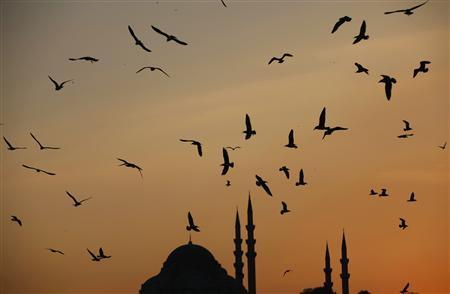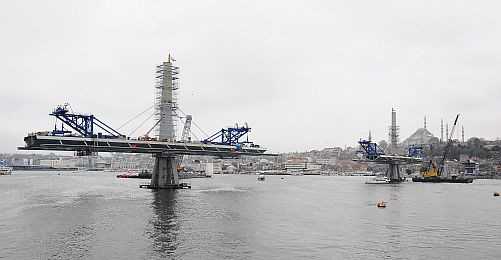By Matt Robinson and Ece Toksabay

ISTANBUL | Thu Nov 29, 2012 6:43am EST
(Reuters) – Tayyip Erdogan has described his third term as Turkish prime minister as that of a “master”, borrowing from the celebrated Ottoman architect Sinan and the last stage of his storied career after apprenticeship and graduation.
It’s a lofty allusion.
Sinan’s 16th-century creations came to define the Ottoman Empire at its apogee, the Suleymaniye Mosque, built for Sultan Suleiman, part of Istanbul’s unmistakable skyline.
Now, entering a second decade at the helm of a country revelling in its regional might, Erdogan wants to leave his own mark on the cityscape with what will be Turkey’s biggest mosque, a “giant mosque,” he says, “that will be visible from all across Istanbul.”
To be built on the highest hill on the Asian side of the Bosphorus, planners boast the structure will hold up to 30,000 worshippers and bear six minarets taller than those of the Al-Masjid al-Nabawi, or the Prophet’s Mosque, in Medina.
It is symbolic of Turkey’s tilt to the east under Erdogan, who has chipped away at the founding secularism of the modern republic and presided over its emergence as a power in the Middle East.
But the Istanbul elite are up in arms.
Some have branded the proposed mosque unsightly and ostentatious, a thinly-disguised declaration of victory by Erdogan’s Islamist-rooted government over the secularists and their guardians in the military.
“On the European side, Sultan Suleiman put his mark on the city with the Suleymaniye Mosque, which could be seen everywhere from old Istanbul,” said Emre Kizilkaya, a blogger and foreign editor at the Hurriyet daily. “Now many think Erdogan wants to put his own mark on the Asian side.”
Picked in mid-November in a hasty competition limited to Turkish architects, the winning design bears a striking resemblance to Istanbul’s iconic 400-year-old Sultanahmet Mosque, or Blue Mosque, built by a student of Sinan.
One religiously conservative intellectual called it a “cheap replica” and wrote to Erdogan imploring him not to embarrass coming generations with such “unsightly work.”
“There’s a saying in Turkish – ‘You don’t discover America again,’” said Oguz Oztuzcu, chairman of the Istanbul Independent Architects’ Association. “You don’t try to make another Sydney Opera House, do you? They’re competing with existing icons.”
Even the country’s culture minister is unconvinced.
“It’s not success in today’s world to build gigantic structures. It was success during the era of Sinan. Now it’s just about how much cement you’re using,” said Ertugrul Gunay, a rare dissenting government voice.
“We should build something like a gem, and it should shine with its beauty, not with its gigantic size.”
EMBRACING IMPERIAL PAST
The mosque will sit atop Camlica Hill, once a hunting ground for the Ottoman well-to-do and now a popular viewing point, where couples sip sweet tea among rose bushes and take pictures with their cell phones of this city of over 14 million people.
Minarets puncture the skyline of European Istanbul.
Backers of the new mosque say they want to create a similar skyline on the Asian side, and do away with the antennas that now blight the hilltop.
Ergin Kulunk, president of the Islamic association overseeing the project, said the Asian side lacked a mosque of such a size to cater to the needs of worshippers.
“It’s a necessity,” he said, and dismissed the storm of criticism over the design, the work of two headscarved female architects.
“We wanted a classical mosque with a dome, and if you’re going to build a classical mosque with a dome, it’s inevitable it will resemble Hagia Sophia, Selimiye Mosque or the Blue Mosque,” he said.
Officially, the government did not instigate the project, but it has given the land and Erdogan’s personal endorsement. The cost is estimated at over 100 million lira, or 43 million euros, to be paid for by donors – code, the opposition says, for businessmen out to curry favour with the government.
The Istanbul Islamic authority, seated near the bustling Grand Bazaar, professed to have little knowledge of the project, but had no complaints. Istanbul has over 3,000 mosques.
Taking its support from the socially conservative Anatolian heartland, Erdogan’s ruling AK Party has all but won the battle with the old secular elite that emerged with the founding of the modern republic in 1923.
It has muzzled the military, upholder of secularism, that had ousted four governments since 1960. Reforms in the military and the judiciary were promoted as complying with change demanded for entry to the European Union EU.L.
With Turkey’s bid to join the EU, however, going nowhere, Erdogan is courting old Ottoman lands in the Middle East.
Economic growth, outstripping Europe, is driven increasingly by trade with the Gulf. Arab businessmen and tourists are flocking to Turkey – up sixfold from Saudi Arabia, 500 percent from Qatar and 400 percent from Kuwait since October 2010.
The government, meanwhile, is embracing Istanbul’s imperial past, when the Ottoman Empire sprawled across three continents.
“We must go everywhere our ancestors have been,” Erdogan said on Sunday, and took aim at the makers of a hit Turkish television series, one of the country’s most famous exports, for its gaudy portrayal of Sultan Suleiman.
“Those who toy with these values should be taught a lesson within the bounds of the law,” he said.
GRAND DESIGNS
Such talk has drawn fire from critics who accuse Erdogan of behaving like a modern-day sultan, at home and abroad. Hundreds of military officers have been jailed on charges of plotting a coup against Erdogan; others including academics, journalists and politicians are facing trial on similar accusations.
Syrian President Bashar al-Assad, smarting from Turkey’s support for the rebels trying to oust him, told a television interviewer this month that Erdogan “thinks he’s the new sultan. In his heart he thinks he’s a Caliph.”
The new mosque, however, will be modest in comparison with others in the Middle East, such as the 600,000-capacity Prophet’s Mosque or the world’s largest, the Al-Masjid al-Haram, or Grand Mosque, in Mecca.
“Any other mosque might be bigger in size, physically and architecturally, but it cannot compare to the two holy mosques due to their sanctity and status,” a Saudi cleric, who declined to be named, told Reuters.
Nor does it compare in scale with Erdogan’s other plans for Istanbul, which include digging a 45-km (30 mile) channel linking the Black Sea to the Sea of Marmara to ease congestion in the Bosphorus Strait and filling in part of the sea to create an assembly ground big enough for 800,000 people.
He hopes, too, to bequeath Turkey a new constitution, replacing the version written after a 1980 military coup and in the process creating a powerful executive presidency.
Barred from running for prime minister again, Erdogan is widely expected to bid for the new presidency in 2014, cementing his status as Turkey’s most significant leader since Mustafa Kemal Ataturk, who founded the secular republic from the World War One ruins of the Ottoman Empire.
“Ottoman sultans adorned the hills of historic Istanbul with mosques dedicated to their victories, creating a lasting legacy,” said Soner Cagaptay, director of the Turkish research program at the Washington Institute for Near East Policy.
“By building a neo-Ottoman style mosque that shall dominate all other Istanbul landmarks, Erdogan is telling the world he has taken over Turkey.” (Additional reporting by Seltem Iyigun in Istanbul and Asma Alsharif in Jeddah; Writing by Matt Robinson; Editing by Nick Tattersall and Ralph Boulton)
 From Our Store: Liturgical Year 2012-2013, Vol. 4: Easter (eBook)
From Our Store: Liturgical Year 2012-2013, Vol. 4: Easter (eBook)




